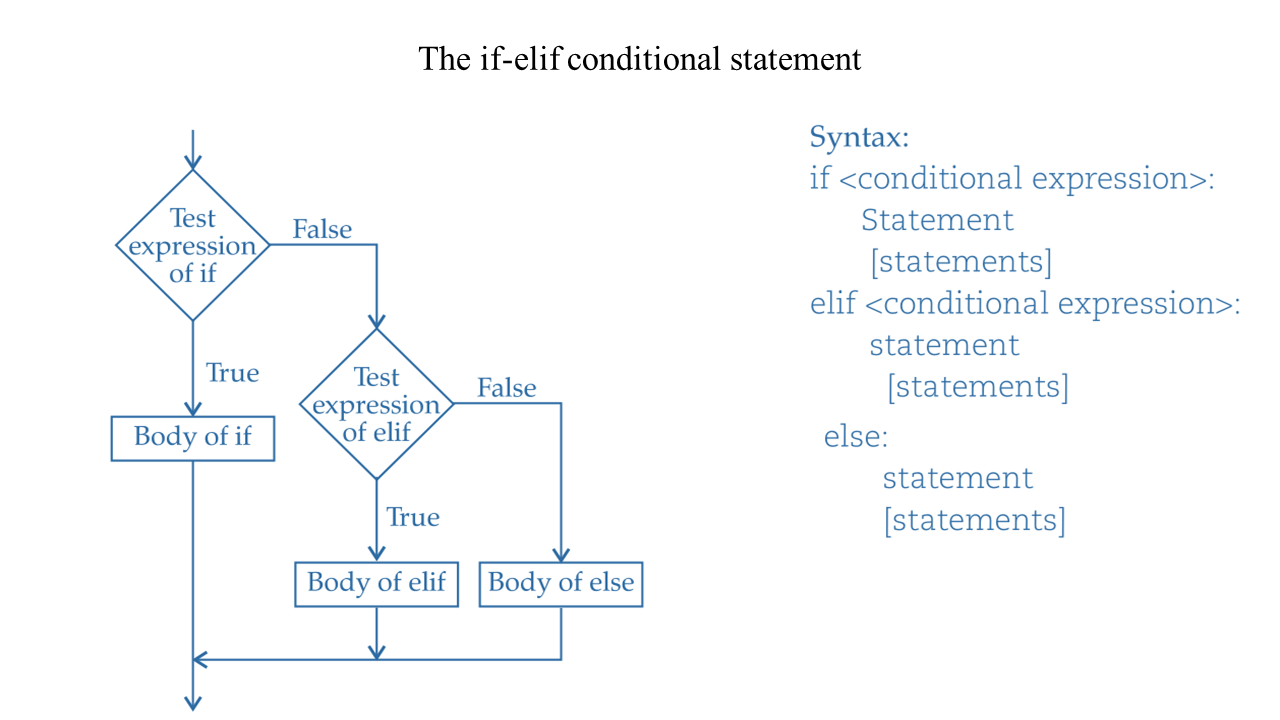
Python if else statement
Table of Content:
- What is decision making in python?
- Syntax of if statement in python
- Indentation in Python
- Example with coding in Python
They’re some situations in real life when we need to make some decisions and based on these decisions, we decide what should we do next. Similar situations arise in programming also where we need to make some decisions and based on these decisions, we will execute the next block of code. Decision-making statements in programming languages decide the direction of the flow of program execution.
Syntax of if statement
Below you can see that this is syntax of if statement.
if condition: statement1 statement2
Indentation: Python relies on indentation (whitespace at the beginning of a line) to define scope in the code. Other programming languages often use curly-brackets for this purpose.
An "if statement" is written by using the if keyword.
Flow chart: Simple if
if conditionals in Python have the following forms.
Example 1: If statement:
a = 33 b = 200 if b > a: print("b is greater than a")
Output:
The above code will produce the following result-
b is greater than a
In this example we use two variables, a and b, which are used as part of the if statement to test whether b is greater than a. As a is 30, and b is 200, we know that 200 is greater than 30, and so we print to screen that "b is greater than a".
Example 2: if statement
Below you can see that this is syntax of if statement.
PI = 3.14
radius = 2.1
if (radius > 0) :
area = radius * radius * PI
print("The area for the circle: ",area)
The area for the circle: 13.8474
Is indentation required in Python?
Indentation is necessary for Python. It specifies a block of code. All code within loops, classes, functions, etc. is specified within an indented block. It is usually done using four space characters. If your code is not indented necessarily, it will not execute accurately and will throw errors as well.
If else in Python Programming Language
- What is if else in python?
- Syntax of if else statement in python
- Flowchart of if else statement in python
- Example of if else with coding in python
Syntax: if else statement
Below you can see that this is syntax of if else statement.
if (condition):
# Executes this block if
# condition is true
else:
# Executes this block if
# condition is false
Flow chart: Simple if
if else conditionals in Python have the following forms.
Example 1: if else statement
Below you can see that this is example of if else statement.
# python program to illustrate If else statement
PI = 3.14
radius = -2
if (radius > 0) :
area = radius * radius * PI
print("The area for the circle: ",area)
else:
print('Input is not valid')
Input is not valid
Example 2: if else statement
Below you can see that one another example of if else statement.
# python program to illustrate If else statement
i = 20
if (i < 15):
print("i is smaller than 15")
print("i'm in if Block")
else:
print("i is greater than 15")
print("i'm in else Block")
print("i'm not in if and not in else Block")
i is greater than 15 i'm in else Block i'm not in if and not in else Block
Example 3: if else statement
Below you can see that one another example of if else statement. Declare a variable i and check that it is positive number or negative number.
i = int(input())
if(i > 0):
print("Positive no")
else:
print("Negative no")
-12 Negative no
The if-elif conditional statement
Syntax
Syntax:
if :
Statement
[statements]
elif :
statement
[statements]
else:
statement
[statements]

Syntax
Syntax: if: Statement [statements] elif : statement [statements] else: statement [statements]
Example: Elif
a = 33 b = 33 if b > a: print("b is greater than a") elif a == b: print("a and b are equal")
Output:
The above code will produce the following result-
In this example a is equal to b, so the first condition is not true, but the elif condition is true, so we print to screen that "a and b are equal".
a and b are equal
Example: Else
Code: The else keyword catches anything which isn't caught by the preceding conditions.
a = 200 b = 33 if b > a: print("b is greater than a") elif a == b: print("a and b are equal") else: print("a is greater than b")
Output:
The above code will produce the following result-
In this example a is greater than b, so the first condition is not true, also the elif condition is not true, so we go to the else condition and print to screen that "a is greater than b".
a is greater than b
Example: Else
Code: You can also have an else without the elif:
a = 200 b = 33 if b > a: print("b is greater than a") else: print("b is not greater than a")
Output:
The above code will produce the following result-
b is not greater than a